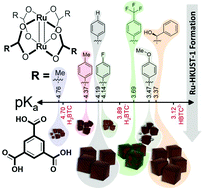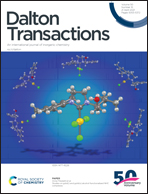Scrutinizing ligand exchange reactions in the formation of the precious group metal–organic framework RuII,II-HKUST-1: the impact of diruthenium tetracarboxylate precursor and modulator choice†
Abstract
The precious group metal (PGM) analogues of the iconic metal–organic framework [Cu3(BTC)2] (HKUST-1; BTC = 1,3,5 benzenetricarboxylate) still represent a synthetic challenge, especially if targeting the univalent and ideally defect-free RuII,II variant. Herein we present a systematic study employing the controlled secondary building unit approach (CSA) by using a variety of diruthenium tetracarboxylate complexes [Ru2(RCO2)4] as precursors in the synthesis of univalent Ru-HKUST-1 samples. Carboxylate ligand exchange test reactions suggest the importance of a pKa match between precursor ligand and BTC linker. For example, L-mandelate substituted precursors resulted in the most “perfect” samples of the investigated series with a fourfold increase in crystalline domain sizes compared to the established acetate route (according to PXRD and HR-TEM), high compositional purity (FT-IR, Raman, TGA and elemental analysis) and feature a so far unprecedentedly high BET surface area of 1789 m2 g−1 with the expected pore size distribution and total pore volume all similar to the ideal HKUST-1 parent structure.



 Please wait while we load your content...
Please wait while we load your content...